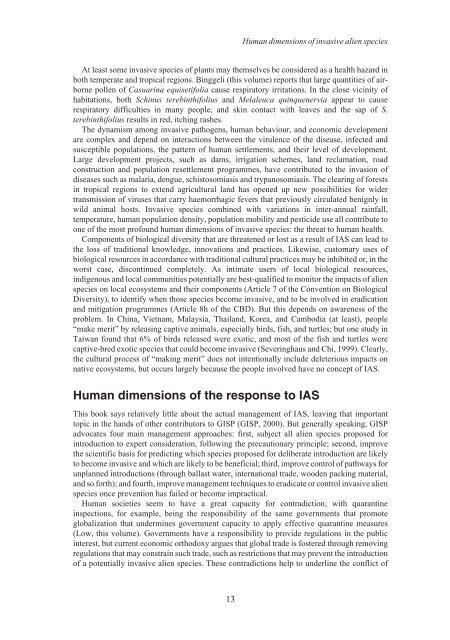Alien Species.vp - IUCN
Alien Species.vp - IUCN
Alien Species.vp - IUCN
Create successful ePaper yourself
Turn your PDF publications into a flip-book with our unique Google optimized e-Paper software.
At least some invasive species of plants may themselves be considered as a health hazard in<br />
both temperate and tropical regions. Binggeli (this volume) reports that large quantities of airborne<br />
pollen of Casuarina equisetifolia cause respiratory irritations. In the close vicinity of<br />
habitations, both Schinus terebinthifolius and Melaleuca quinquenervia appear to cause<br />
respiratory difficulties in many people, and skin contact with leaves and the sap of S.<br />
terebinthifolius results in red, itching rashes.<br />
The dynamism among invasive pathogens, human behaviour, and economic development<br />
are complex and depend on interactions between the virulence of the disease, infected and<br />
susceptible populations, the pattern of human settlements, and their level of development.<br />
Large development projects, such as dams, irrigation schemes, land reclamation, road<br />
construction and population resettlement programmes, have contributed to the invasion of<br />
diseases such as malaria, dengue, schistosomiasis and trypanosomiasis. The clearing of forests<br />
in tropical regions to extend agricultural land has opened up new possibilities for wider<br />
transmission of viruses that carry haemorrhagic fevers that previously circulated benignly in<br />
wild animal hosts. Invasive species combined with variations in inter-annual rainfall,<br />
temperature, human population density, population mobility and pesticide use all contribute to<br />
one of the most profound human dimensions of invasive species: the threat to human health.<br />
Components of biological diversity that are threatened or lost as a result of IAS can lead to<br />
the loss of traditional knowledge, innovations and practices. Likewise, customary uses of<br />
biological resources in accordance with traditional cultural practices may be inhibited or, in the<br />
worst case, discontinued completely. As intimate users of local biological resources,<br />
indigenous and local communities potentially are best-qualified to monitor the impacts of alien<br />
species on local ecosystems and their components (Article 7 of the Convention on Biological<br />
Diversity), to identify when those species become invasive, and to be involved in eradication<br />
and mitigation programmes (Article 8h of the CBD). But this depends on awareness of the<br />
problem. In China, Vietnam, Malaysia, Thailand, Korea, and Cambodia (at least), people<br />
“make merit” by releasing captive animals, especially birds, fish, and turtles; but one study in<br />
Taiwan found that 6% of birds released were exotic, and most of the fish and turtles were<br />
captive-bred exotic species that could become invasive (Severinghaus and Chi, 1999). Clearly,<br />
the cultural process of “making merit” does not intentionally include deleterious impacts on<br />
native ecosystems, but occurs largely because the people involved have no concept of IAS.<br />
Human dimensions of the response to IAS<br />
This book says relatively little about the actual management of IAS, leaving that important<br />
topic in the hands of other contributors to GISP (GISP, 2000). But generally speaking, GISP<br />
advocates four main management approaches: first, subject all alien species proposed for<br />
introduction to expert consideration, following the precautionary principle; second, improve<br />
the scientific basis for predicting which species proposed for deliberate introduction are likely<br />
to become invasive and which are likely to be beneficial; third, improve control of pathways for<br />
unplanned introductions (through ballast water, international trade, wooden packing material,<br />
and so forth); and fourth, improve management techniques to eradicate or control invasive alien<br />
species once prevention has failed or become impractical.<br />
Human societies seem to have a great capacity for contradiction, with quarantine<br />
inspections, for example, being the responsibility of the same governments that promote<br />
globalization that undermines government capacity to apply effective quarantine measures<br />
(Low, this volume). Governments have a responsibility to provide regulations in the public<br />
interest, but current economic orthodoxy argues that global trade is fostered through removing<br />
regulations that may constrain such trade, such as restrictions that may prevent the introduction<br />
of a potentially invasive alien species. These contradictions help to underline the conflict of<br />
13<br />
Human dimensions of invasive alien species












